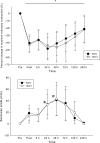Does high muscle temperature accentuate skeletal muscle injury from eccentric exercise?
- PMID: 27185904
- PMCID: PMC4873630
- DOI: 10.14814/phy2.12777
Does high muscle temperature accentuate skeletal muscle injury from eccentric exercise?
Abstract
Hyperthermia is suspected of accentuating skeletal muscle injury from novel exercise, but this has not been well studied. This study examined if high muscle temperatures alters skeletal muscle injury induced by eccentric exercise (ECC). Eight volunteers (age, 22.5 ± 4.1 year; height, 169.5 ± 10.8 cm; body mass, 76.2 ± 12.6 kg), serving as their own control, and who were not heat acclimatized, completed two elbow flexor ECC trials; in one trial the biceps were heated >40°C (HEAT) and in the other trial there was no heating (NON). HEAT was applied with shortwave diathermy (100 W) for 15 min immediately before the first ECC bout and for 2 min in between each bout. Individuals were followed for 10 days after each ECC session, with a 6-week washout period between arms. The maximal voluntary isometric contraction decreased by 41 ± 17% and 46 ± 20% in the NON and HEAT trials, respectively. Bicep circumference increased by 0.07 ± 0.08 mm (4%, P = 0.04) and relaxed range of motion decreased by 11.5 ± 8.2° (30%, P < 0.001) in both trials. Serum creatine kinase peaked 72-h following ECC (NON: 6289 ± 10407; HEAT: 5486 ± 6229 IU L(-1), 38-fold increase, P < 0.01) as did serum myoglobin (NON: 362 ± 483; HEAT: 355 ± 373 μg L(-1), 13-fold increase, P < 0.03). Plasma HSP 70 was higher (P < 0.02) in HEAT after 120-h of recovery. There were no differences between treatments for plasma HSP27 and interleukins 1β, 6, and 10. The results indicate that >40°C muscle temperature does not alter skeletal muscle injury or functional impairments induced by novel ECC.
Keywords: Cytokines; eccentric exercise; heat‐shock proteins; interleukins; maximal voluntary contraction.
Published 2016. This article is a U.S. Government work and is in the public domain in the USA. Physiological Reports published by Wiley Periodicals, Inc. on behalf of The Physiological Society and the American Physiological Society.
Figures



Similar articles
-
Attenuation of eccentric exercise-induced muscle damage by preconditioning exercises.Med Sci Sports Exerc. 2012 Nov;44(11):2090-8. doi: 10.1249/MSS.0b013e31825f69f3. Med Sci Sports Exerc. 2012. PMID: 22688830
-
Influence of previous concentric exercise on eccentric exercise-induced muscle damage.J Sports Sci. 1997 Oct;15(5):477-83. doi: 10.1080/026404197367119. J Sports Sci. 1997. PMID: 9386205 Clinical Trial.
-
Responses of human elbow flexor muscles to electrically stimulated forced lengthening exercise.Acta Physiol Scand. 2002 Feb;174(2):137-45. doi: 10.1046/j.1365-201X.2002.00936.x. Acta Physiol Scand. 2002. PMID: 11860376
-
Partial protection against muscle damage by eccentric actions at short muscle lengths.Med Sci Sports Exerc. 2005 May;37(5):746-53. doi: 10.1249/01.mss.0000162691.66162.00. Med Sci Sports Exerc. 2005. PMID: 15870627
-
Concentric or eccentric training effect on eccentric exercise-induced muscle damage.Med Sci Sports Exerc. 2002 Jan;34(1):63-9. doi: 10.1097/00005768-200201000-00011. Med Sci Sports Exerc. 2002. PMID: 11782649 Clinical Trial.
Cited by
-
TECAR Therapy Associated with High-Intensity Laser Therapy (Hilt) and Manual Therapy in the Treatment of Muscle Disorders: A Literature Review on the Theorised Effects Supporting Their Use.J Clin Med. 2022 Oct 19;11(20):6149. doi: 10.3390/jcm11206149. J Clin Med. 2022. PMID: 36294470 Free PMC article. Review.
-
Osmolality Selectively Offsets the Impact of Hyperthermia on Mouse Skeletal Muscle in vitro.Front Physiol. 2018 Oct 31;9:1496. doi: 10.3389/fphys.2018.01496. eCollection 2018. Front Physiol. 2018. PMID: 30429796 Free PMC article.
-
Controlled Heat Stress Promotes Myofibrillogenesis during Myogenesis.PLoS One. 2016 Nov 8;11(11):e0166294. doi: 10.1371/journal.pone.0166294. eCollection 2016. PLoS One. 2016. PMID: 27824934 Free PMC article.
-
Turning Up the Heat: An Evaluation of the Evidence for Heating to Promote Exercise Recovery, Muscle Rehabilitation and Adaptation.Sports Med. 2018 Jun;48(6):1311-1328. doi: 10.1007/s40279-018-0876-6. Sports Med. 2018. PMID: 29470824 Review.
-
No clear benefit of muscle heating on hypertrophy and strength with resistance training.Temperature (Austin). 2017 Dec 7;5(2):175-183. doi: 10.1080/23328940.2017.1391366. eCollection 2018. Temperature (Austin). 2017. PMID: 30393753 Free PMC article.
References
-
- Armed Forces Health Surveillance Center . 2009. Update: exertional rhabdomyolysis among U.S. military members, 2008. Medical Surveillance Monthly Report 10‐13.
-
- Brock Symons, T. , Clasey J. L., Gater D. R., and Yates J. W.. 2004. Effects of deep heat as a preventative mechanism on delayed onset muscle soreness. J. Strength Cond. Res. 18:155–161. - PubMed
-
- Carter, R. , Cheuvront S. N., Williams J. O., Kolka M. A., Stephenson L. A., Sawka M. N., et al. 2005. Epidemiology of hospitalizations and deaths from heat illness in soldiers. Med. Sci. Sports Exerc. 37:1338–1344. - PubMed
MeSH terms
LinkOut - more resources
Full Text Sources
Other Literature Sources
Medical
Research Materials
Miscellaneous

